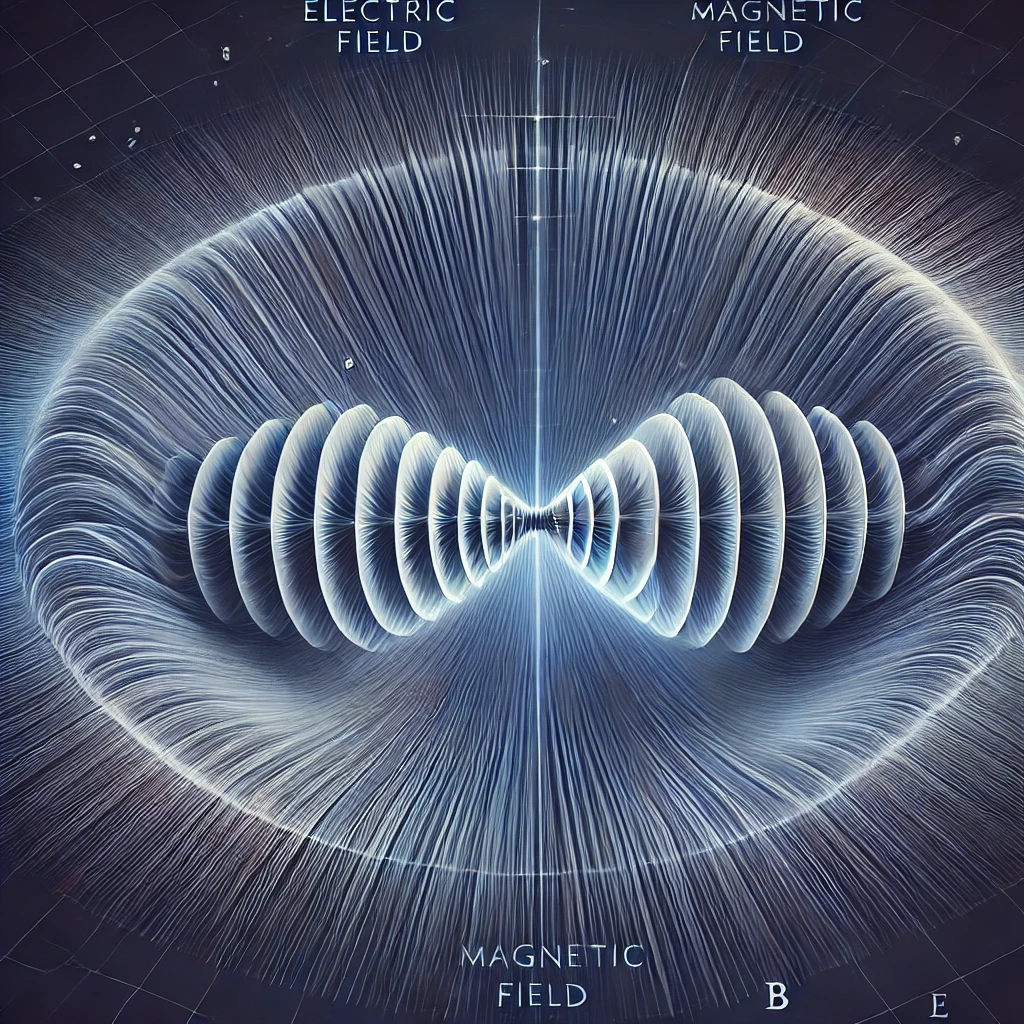
Electromagnetic waves: What are and how to understand them?
Mike MunayShare
In today's article, we will not only explain what electromagnetic waves are, but we will also deep dive into their physical components. This way, you will be able to learn about the different parts of a wave and better understand the basic concepts that we encounter in our daily lives.
What are electromagnetic waves?
Electromagnetic waves are periodic disturbances or variations in electric and magnetic fields that propagate through space. These waves transport energy from one place to another without the need for a material medium, which means that they can travel through a vacuum, which is why communication waves can also travel through space.
Electromagnetic waves are present in almost every aspect of our lives in multiple forms. From sunlight to the internet. They are the backbone of most technological aspects, which is why they are so important.
- Any transmission of information by cable (such as optical fiber) or by air (antennas of all kinds) is done through electromagnetic waves, therefore the Internet, telephony or satellite communications are electromagnetic waves.
- Radio, TV, Wi-Fi, Bluetooth...
- Any device that uses laser beams
- X-rays, MRIs, CT scans... But NOT ultrasounds, as these are ultrasounds, and although it is a type of wave, it is not an electromagnetic wave. You were probably thinking this right now, but the answer is: NO, an ultrasound machine does not work in outer space.
- Microwaves, induction hobs
- Any device that uses different light spectrums (X-rays, gamma rays, microwaves, infrared, ultraviolet...)
- Any type of ionizing radiation
- Radars
- Telescopes
- Solar panels
- Wireless charging
The list of applications is endless, as they are present in almost every technological item.
When we talk about electromagnetic waves, we usually refer to those electromagnetic waves that are used for a purpose, such as those described above, but going to the more precise physical description, it is important to explain that every variable electric field has an associated magnetic field, and vice versa.
In practice, this indicates that, for example, every electric current that varies generates a magnetic field (like electricity traveling through a cable), and that every magnetic field that varies generates an electric field (like a magnet moving within a circuit.
Examples:
- An alternating current electric cable constantly generates a magnetic field around the cable. In this case the magnetic field is useless, but it exists and is there, which is why it is called electric current, although it is actually an electromagnetic current.
- A magnet that we move through a coil of wire generates an electric field that can turn on a light bulb, for example (a common practical exercise in physics subjects at universities). As the principle applies to moving fields, the bulb will only turn on as long as we move the magnet, and if it remains still, the bulb will turn off.
These principles are described in the Faraday-Lenz Law, which in turn is one of the 4 Maxwell equations that explain all electromagnetic phenomena.
What are Maxwell's equations?
Maxwell's equations are a set of four fundamental equations that describe how electric and magnetic fields interact with each other and with matter. These equations form the basis of the classical theory of electromagnetism and are essential to understanding electrical, magnetic, and optical phenomena.
Maxwell's equations unified the electric and magnetic fields into a single coherent theory and predicted the existence of electromagnetic waves (like light), which travel at the speed of light. These equations also demonstrated that light is an electromagnetic wave, thus revolutionizing our understanding of the nature of light and laying the foundation for many modern technologies.
The theory on the nature of light will be the subject of a separate article in the future as it is quite extensive.
Originally there were 20 equations but they were finally summarized in 4. Maxwell's equations are based on the work of Gauss, Faraday, Lenz, Ampère and Maxwell himself.
1. Gauss's law of the electric field.
This equation states that the electric field flux through a closed surface is proportional to the total electric charge within that surface. It is a mathematical way of stating that electric charges are the sources of electric fields. In practice, this means that the electric field diverges away from positive charges and converges toward negative charges.
2. Gauss's law of magnetic field
This equation states that the magnetic field flux through any closed surface is zero. This implies that there are no magnetic monopoles; that is, magnetic field lines are always closed, with no beginning or end. This means that the magnetic field has no sources or sinks, which means that magnetic poles always come in pairs (north and south) and that if one magnetic pole were isolated, the magnetic field would cease to exist.
This rule says that you can't have just one magnetic pole. Magnetic fields always go out one way and in the other, like the invisible lines that connect the north and south poles of a magnet. It doesn't matter if you split a magnet in two, it automatically readjusts to still have 2 different poles.
3. Faraday-Lenz law of electromagnetic induction
This equation describes how a time-varying magnetic field generates an electric field. It is the basis for the operation of electrical transformers and generators. This means that a changing magnetic field induces an electric field and vice versa.
An example of this is wireless chargers, which generate a magnetic field in the charger, which is received by the mobile phone. As every magnetic field has an associated electric field, this property is used to extract the electric field and charge the battery with it.
4. Ampere-Maxwell law
This equation shows that a magnetic field can be generated by either an electric current or a time-varying electric field. Maxwell added the displacement term to correct Ampere's law, allowing the equations to be consistent even in vacuum.
This rule is important for understanding how things like electromagnets work. When electricity passes through a wire, it creates a magnetic field that can be used to lift heavy things.
How are electromagnetic waves represented?
When we represent an electromagnetic wave on a graph, we represent its properties in a way that can be interpreted and used to understand the wave or make calculations necessary for some purpose.
When representing the electromagnetic wave, on the X axis (horizontal) we will always put the time component, and on the Y axis the amplitude (the voltage) of the electromagnetic wave.

Looking at the image, we have the representation of an electromagnetic wave that takes values between 2 and -2 over time.
With this we can now talk about the components or parts of a wave.
Frequency and period: These components are inverses of each other, meaning that if you have one you have the other. Frequency is the period raised to the power of -1 and vice versa. The wave is measured in Hertz (Hz) and the period in seconds (s).
An electromagnetic wave is characterized by its periodic oscillation. In each cycle, the wave passes through a set of points: it starts at a value, reaches a maximum (crest), descends to a minimum (valley) and returns to its initial value.
Phase is measured in degrees or radians. One complete cycle of the wave corresponds to 360 degrees or 2 π radians.
- 0 degrees (0 radians) corresponds to the starting point of the cycle.
- 90 degrees ( π/2 radians ) corresponds to the crest.
- 180 degrees ( π radians ) corresponds to the descending midpoint.
- 270 degrees (3 π/2 radians ) corresponds to the valley.
- 360 degrees ( 2 π radians ) corresponds to the end of one cycle and the beginning of the next.
Phase is crucial in wave interference. When two waves of the same frequency and amplitude meet, the result depends on their phase difference:
- Constructive interference occurs if the waves are in phase (their phase difference is 0 or a multiple of 360 degrees), resulting in a wave with a larger amplitude. This characteristic is used, for example, by signal amplifiers.
- Destructive interference occurs if the waves are out of phase (their phase difference is 180 degrees), which can result in partial or complete cancellation. This feature is used, for example, by noise-cancelling headphones, which generate destructive interference with outside sound to produce a neutral sound that cannot be perceived by the human ear.
We hope you have learned a little about how electromagnetic waves work.
If you liked it, please share and comment :)

1 comment
Didáctico y entretenido